10.3E: Exercises
- Page ID
- 120524
\( \newcommand{\vecs}[1]{\overset { \scriptstyle \rightharpoonup} {\mathbf{#1}} } \)
\( \newcommand{\vecd}[1]{\overset{-\!-\!\rightharpoonup}{\vphantom{a}\smash {#1}}} \)
\( \newcommand{\id}{\mathrm{id}}\) \( \newcommand{\Span}{\mathrm{span}}\)
( \newcommand{\kernel}{\mathrm{null}\,}\) \( \newcommand{\range}{\mathrm{range}\,}\)
\( \newcommand{\RealPart}{\mathrm{Re}}\) \( \newcommand{\ImaginaryPart}{\mathrm{Im}}\)
\( \newcommand{\Argument}{\mathrm{Arg}}\) \( \newcommand{\norm}[1]{\| #1 \|}\)
\( \newcommand{\inner}[2]{\langle #1, #2 \rangle}\)
\( \newcommand{\Span}{\mathrm{span}}\)
\( \newcommand{\id}{\mathrm{id}}\)
\( \newcommand{\Span}{\mathrm{span}}\)
\( \newcommand{\kernel}{\mathrm{null}\,}\)
\( \newcommand{\range}{\mathrm{range}\,}\)
\( \newcommand{\RealPart}{\mathrm{Re}}\)
\( \newcommand{\ImaginaryPart}{\mathrm{Im}}\)
\( \newcommand{\Argument}{\mathrm{Arg}}\)
\( \newcommand{\norm}[1]{\| #1 \|}\)
\( \newcommand{\inner}[2]{\langle #1, #2 \rangle}\)
\( \newcommand{\Span}{\mathrm{span}}\) \( \newcommand{\AA}{\unicode[.8,0]{x212B}}\)
\( \newcommand{\vectorA}[1]{\vec{#1}} % arrow\)
\( \newcommand{\vectorAt}[1]{\vec{\text{#1}}} % arrow\)
\( \newcommand{\vectorB}[1]{\overset { \scriptstyle \rightharpoonup} {\mathbf{#1}} } \)
\( \newcommand{\vectorC}[1]{\textbf{#1}} \)
\( \newcommand{\vectorD}[1]{\overrightarrow{#1}} \)
\( \newcommand{\vectorDt}[1]{\overrightarrow{\text{#1}}} \)
\( \newcommand{\vectE}[1]{\overset{-\!-\!\rightharpoonup}{\vphantom{a}\smash{\mathbf {#1}}}} \)
\( \newcommand{\vecs}[1]{\overset { \scriptstyle \rightharpoonup} {\mathbf{#1}} } \)
\( \newcommand{\vecd}[1]{\overset{-\!-\!\rightharpoonup}{\vphantom{a}\smash {#1}}} \)
Exercises
In Exercises 1 - 20, find the exact value or state that it is undefined.
- \(\tan \left( \dfrac{\pi}{4} \right)\)
- \(\sec \left( \dfrac{\pi}{6} \right)\)
- \(\csc \left( \dfrac{5\pi}{6} \right)\)
- \(\cot \left( \dfrac{4\pi}{3} \right)\)
- \(\tan \left( -\dfrac{11\pi}{6} \right)\)
- \(\sec \left( -\dfrac{3\pi}{2} \right)\)
- \(\csc \left( -\dfrac{\pi}{3} \right)\)
- \(\cot \left( \dfrac{13\pi}{2} \right)\)
- \(\tan \left( 117\pi \right)\)
- \(\sec \left( -\dfrac{5\pi}{3} \right)\)
- \(\csc \left( 3\pi \right)\)
- \(\cot \left( -5\pi \right)\)
- \(\tan \left( \dfrac{31\pi}{2} \right)\)
- \(\sec \left( \dfrac{\pi}{4} \right)\)
- \(\csc \left( -\dfrac{7\pi}{4} \right)\)
- \(\cot \left( \dfrac{7\pi}{6} \right)\)
- \(\tan \left( \dfrac{2\pi}{3} \right)\)
- \(\sec \left( -7\pi \right)\)
- \(\csc \left( \dfrac{\pi}{2} \right)\)
- \(\cot \left( \dfrac{3\pi}{4} \right)\)
In Exercises 21 - 34, use the given the information to find the exact values of the remaining circular functions of \(\theta\).
- \(\sin(\theta) = \dfrac{3}{5}\) with \(\theta\) in Quadrant II
- \(\tan(\theta) = \dfrac{12}{5}\) with \(\theta\) in Quadrant III
- \(\csc(\theta) = \dfrac{25}{24}\) with \(\theta\) in Quadrant I
- \(\sec(\theta) = 7\) with \(\theta\) in Quadrant IV
- \(\csc(\theta) = -\dfrac{10\sqrt{91}}{91}\) with \(\theta\) in Quadrant III
- \(\cot(\theta) = -23\) with \(\theta\) in Quadrant II
- \(\tan(\theta) = -2\) with \(\theta\) in Quadrant IV.
- \(\sec(\theta) = -4\) with \(\theta\) in Quadrant II.
- \(\cot(\theta) = \sqrt{5}\) with \(\theta\) in Quadrant III.
- \(\cos(\theta) = \dfrac{1}{3}\) with \(\theta\) in Quadrant I.
- \(\cot(\theta) = 2\) with \(0 < \theta < \dfrac{\pi}{2}\).
- \(\csc(\theta) = 5\) with \(\dfrac{\pi}{2} < \theta < \pi\).
- \(\tan(\theta) = \sqrt{10}\) with \(\pi < \theta < \dfrac{3\pi}{2}\).
- \(\sec(\theta) = 2\sqrt{5}\) with \(\dfrac{3\pi}{2} < \theta < 2\pi\).
In Exercises 35 - 42, use your calculator to approximate the given value to three decimal places. Make sure your calculator is in the proper angle measurement mode!
- \(\csc(78.95^{\circ})\)
- \(\tan(-2.01)\)
- \(\cot(392.994)\)
- \(\sec(207^{\circ})\)
- \(\csc(5.902)\)
- \(\tan(39.672^{\circ})\)
- \(\cot(3^{\circ})\)
- \(\sec(0.45)\)
In Exercises 43 - 57, find all of the angles which satisfy the equation.
- \(\tan(\theta) = \sqrt{3}\)
- \(\sec(\theta) = 2\)
- \(\csc(\theta) = -1\)
- \(\cot(\theta) = \dfrac{\sqrt{3}}{3}\)
- \(\tan(\theta) = 0\)
- \(\sec(\theta) = 1\)
- \(\csc(\theta) = 2\)
- \(\cot(\theta) = 0\)
- \(\tan(\theta) = -1\)
- \(\sec(\theta) = 0\)
- \(\csc(\theta) = -\dfrac{1}{2}\)
- \(\sec(\theta) = -1\)
- \(\tan(\theta) = -\sqrt{3}\)
- \(\csc(\theta) = -2\)
- \(\cot(\theta) = -1\)
In Exercises 58 - 65, solve the equation for \(t\). Give exact values.
- \(\cot(t) = 1\)
- \(\tan(t) = \dfrac{\sqrt{3}}{3}\)
- \(\sec(t) = -\dfrac{2\sqrt{3}}{3}\)
- \(\csc(t) = 0\)
- \(\cot(t) = -\sqrt{3}\)
- \(\tan(t) = -\dfrac{\sqrt{3}}{3}\)
- \(\sec(t) = \dfrac{2\sqrt{3}}{3}\)
- \(\csc(t) = \dfrac{2\sqrt{3}}{3}\)
In Exercises 66 - 69, use Theorem 10.3.6 to find the requested quantities.
- Find \(\theta\), \(a\), and \(c\).
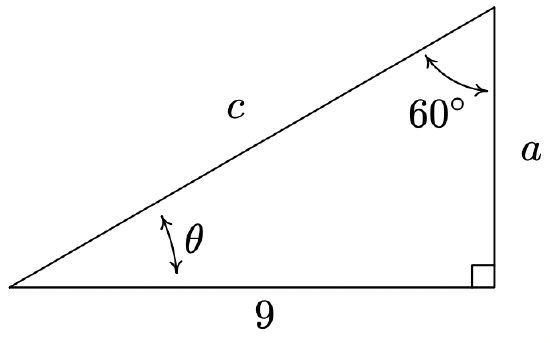
- Find \(\alpha\), \(b\), and \(c\).
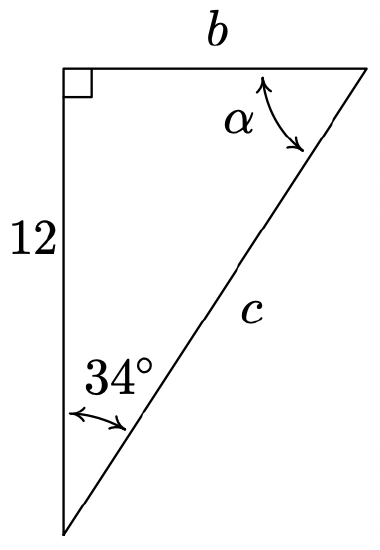
- Find \(\theta\), \(a\), and \(c\).
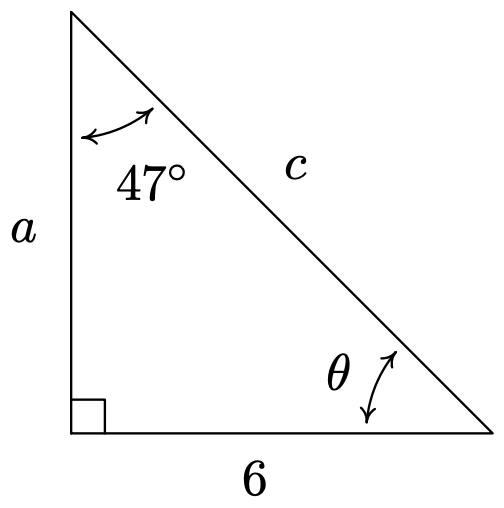
- Find \(\beta\), \(b\), and \(c\).
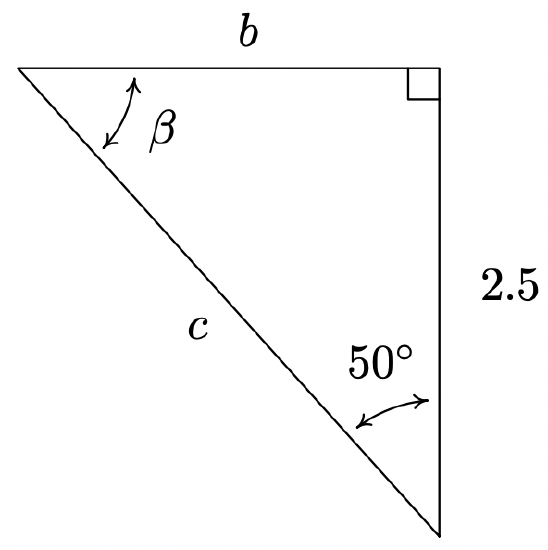
In Exercises 70 - 75, use Theorem 10.3.6 to answer the question. Assume that \(\theta\) is an angle in a right triangle.
- If \(\theta = 30^{\circ}\) and the side opposite \(\theta\) has length \(4\), how long is the side adjacent to \(\theta\)?
- If \(\theta = 15^{\circ}\) and the hypotenuse has length \(10\), how long is the side opposite \(\theta\)?
- If \(\theta = 87^{\circ}\) and the side adjacent to \(\theta\) has length \(2\), how long is the side opposite \(\theta\)?
- If \(\theta = 38.2^{\circ}\) and the side opposite \(\theta\) has lengh \(14\), how long is the hypoteneuse?
- If \(\theta = 2.05^{\circ}\) and the hypotenuse has length \(3.98\), how long is the side adjacent to \(\theta\)?
- If \(\theta = 42^{\circ}\) and the side adjacent to \(\theta\) has length \(31\), how long is the side opposite \(\theta\)?
- A tree standing vertically on level ground casts a 120 foot long shadow. The angle of elevation from the end of the shadow to the top of the tree is \(21.4^{\circ}\). Find the height of the tree to the nearest foot. With the help of your classmates, research the term umbra versa and see what it has to do with the shadow in this problem.
- The broadcast tower for radio station WSAZ (Home of “Algebra in the Morning with Carl and Jeff”) has two enormous flashing red lights on it: one at the very top and one a few feet below the top. From a point 5000 feet away from the base of the tower on level ground the angle of elevation to the top light is \(7.970^{\circ}\) and to the second light is \(7.125^{\circ}\). Find the distance between the lights to the nearest foot.
- On page 753 we defined the angle of inclination (also known as the angle of elevation) and in this exercise we introduce a related angle - the angle of depression (also known as the angle of declination). The angle of depression of an object refers to the angle whose initial side is a horizontal line above the object and whose terminal side is the line-of-sight to the object below the horizontal. This is represented schematically below.
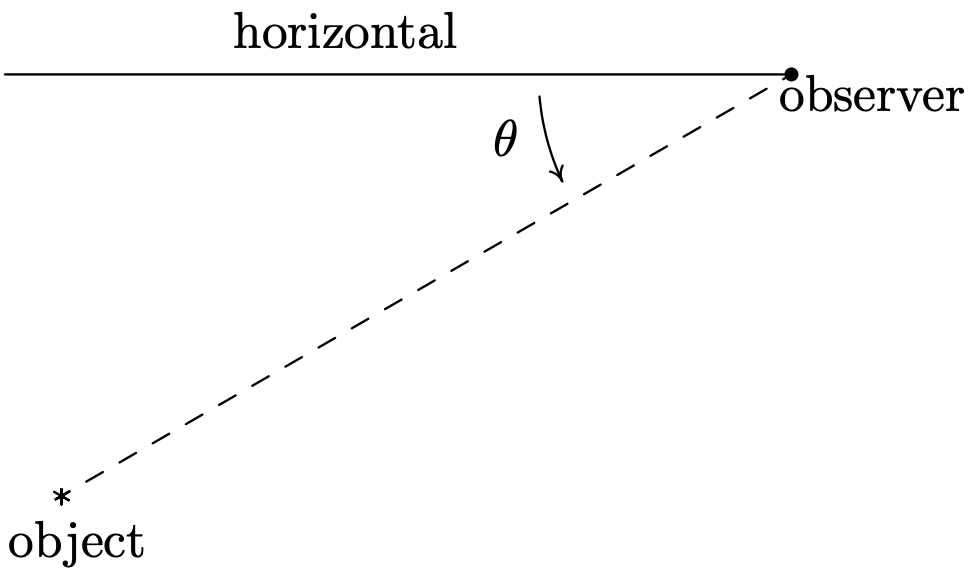 The angle of depression from the horizontal to the object is θ
The angle of depression from the horizontal to the object is θ- Show that if the horizontal is above and parallel to level ground then the angle of depression (from observer to object) and the angle of inclination (from object to observer) will be congruent because they are alternate interior angles.
- From a firetower 200 feet above level ground in the Sasquatch National Forest, a ranger spots a fire off in the distance. The angle of depression to the fire is 2.5o . How far away from the base of the tower is the fire?
- The ranger in part 78b sees a Sasquatch running directly from the fire towards the firetower. The ranger takes two sightings. At the first sighting, the angle of depression from the tower to the Sasquatch is 6o . The second sighting, taken just 10 seconds later, gives the the angle of depression as 6.5o. How far did the Saquatch travel in those 10 seconds? Round your answer to the nearest foot. How fast is it running in miles per hour? Round your answer to the nearest mile per hour. If the Sasquatch keeps up this pace, how long will it take for the Sasquatch to reach the firetower from his location at the second sighting? Round your answer to the nearest minute.
- When I stand 30 feet away from a tree at home, the angle of elevation to the top of the tree is \(50^{\circ}\) and the angle of depression to the base of the tree is \(10^{\circ}\). What is the height of the tree? Round your answer to the nearest foot.
- From the observation deck of the lighthouse at Sasquatch Point 50 feet above the surface of Lake Ippizuti, a lifeguard spots a boat out on the lake sailing directly toward the lighthouse. The first sighting had an angle of depression of \(8.2^{\circ}\) and the second sighting had an angle of depression of \(25.9^{\circ}\). How far had the boat traveled between the sightings?
- A guy wire 1000 feet long is attached to the top of a tower. When pulled taut it makes a \(43^{\circ}\) angle with the ground. How tall is the tower? How far away from the base of the tower does the wire hit the ground?
In Exercises 82 - 128, verify the identity. Assume that all quantities are defined.
- \(\cos(\theta) \sec(\theta) = 1\)
- \(\tan(\theta)\cos(\theta) = \sin(\theta)\)
- \(\sin(\theta) \csc(\theta) = 1\)
- \(\tan(\theta) \cot(\theta) = 1\)
- \(\csc(\theta) \cos(\theta) = \cot(\theta)\)
- \(\dfrac{\sin(\theta)}{\cos^{2}(\theta)} = \sec(\theta) \tan(\theta)\)
- \(\dfrac{\cos(\theta)}{\sin^{2}(\theta)} = \csc(\theta) \cot(\theta)\)
- \(\dfrac{1+ \sin(\theta)}{\cos(\theta)} = \sec(\theta) + \tan(\theta)\)
- \(\dfrac{1 - \cos(\theta)}{\sin(\theta)} = \csc(\theta) - \cot(\theta)\)
- \(\dfrac{\cos(\theta)}{1 - \sin^{2}(\theta)} = \sec(\theta)\)
- \(\dfrac{\sin(\theta)}{1 - \cos^{2}(\theta)} = \csc(\theta)\)
- \(\dfrac{\sec(\theta)}{1 + \tan^{2}(\theta)} = \cos(\theta)\)
- \(\dfrac{\csc(\theta)}{1 + \cot^{2}(\theta)} = \sin(\theta)\)
- \(\dfrac{\tan(\theta)}{\sec^{2}(\theta) - 1} = \cot(\theta)\)
- \(\dfrac{\cot(\theta)}{\csc^{2}(\theta) - 1} = \tan(\theta)\)
- \(4 \cos^{2}(\theta) + 4 \sin^{2}(\theta) = 4\)
- \(9 - \cos^{2}(\theta) - \sin^{2}(\theta) = 8\)
- \(\tan^{3}(\theta) = \tan(\theta)\sec^{2}(\theta) - \tan(\theta)\)
- \(\sin^{5}(\theta) = \left(1-\cos^{2}(\theta)\right)^{2} \sin(\theta)\)
- \(\sec^{10}(\theta) = \left(1 + \tan^{2}(\theta)\right)^4 \sec^{2}(\theta)\)
- \(\cos^{2}(\theta)\tan^{3}(\theta) = \tan(\theta) - \sin(\theta)\cos(\theta)\)
- \(\sec^{4}(\theta) - \sec^{2}(\theta) = \tan^{2}(\theta) + \tan^{4}(\theta)\)
- \(\dfrac{\cos(\theta) + 1}{\cos(\theta) - 1} = \dfrac{1 + \sec(\theta)}{1 - \sec(\theta)}\)
- \(\dfrac{\sin(\theta) + 1}{\sin(\theta) - 1} = \dfrac{1 + \csc(\theta)}{1 - \csc(\theta)}\)
- \(\dfrac{1 - \cot(\theta)}{1+ \cot(\theta)} = \dfrac{\tan(\theta) - 1}{\tan(\theta) + 1}\)
- \(\dfrac{1 - \tan(\theta)}{1+ \tan(\theta)} = \dfrac{\cos(\theta) - \sin(\theta)}{\cos(\theta) + \sin(\theta)}\)
- \(\tan(\theta) + \cot(\theta) = \sec(\theta)\csc(\theta)\)
- \(\csc(\theta) - \sin(\theta) = \cot(\theta)\cos(\theta)\)
- \(\cos(\theta) - \sec(\theta) = -\tan(\theta)\sin(\theta)\)
- \(\cos(\theta)(\tan(\theta) + \cot(\theta)) = \csc(\theta)\)
- \(\sin(\theta)(\tan(\theta) + \cot(\theta)) = \sec(\theta)\)
- \(\dfrac{1}{1-\cos(\theta)} + \dfrac{1}{1+\cos(\theta)} = 2\csc^{2}(\theta)\)
- \(\dfrac{1}{\sec(\theta) + 1} + \dfrac{1}{\sec(\theta)-1} = 2 \csc(\theta) \cot(\theta)\)
- \(\dfrac{1}{\csc(\theta) + 1} + \dfrac{1}{\csc(\theta)-1} = 2 \sec(\theta) \tan(\theta)\)
- \(\dfrac{1}{\csc(\theta)-\cot(\theta)} - \dfrac{1}{\csc(\theta) + \cot(\theta)} = 2 \cot(\theta)\)
- \(\dfrac{\cos(\theta)}{1 - \tan(\theta)} + \dfrac{\sin(\theta)}{1 - \cot(\theta)} = \sin(\theta) + \cos(\theta)\)
- \(\dfrac{1}{\sec(\theta) + \tan(\theta)} = \sec(\theta) - \tan(\theta)\)
- \(\dfrac{1}{\sec(\theta) - \tan(\theta)} = \sec(\theta) + \tan(\theta)\)
- \(\dfrac{1}{\csc(\theta) - \cot(\theta)} = \csc(\theta) + \cot(\theta)\)
- \(\dfrac{1}{\csc(\theta) + \cot(\theta)} = \csc(\theta) - \cot(\theta)\)
- \(\dfrac{1}{1-\sin(\theta)} = \sec^{2}(\theta) + \sec(\theta) \tan(\theta)\)
- \(\dfrac{1}{1+\sin(\theta)} = \sec^{2}(\theta) - \sec(\theta) \tan(\theta)\)
- \(\dfrac{1}{1-\cos(\theta)} = \csc^{2}(\theta) + \csc(\theta) \cot(\theta)\)
- \(\dfrac{1}{1+\cos(\theta)} = \csc^{2}(\theta) - \csc(\theta) \cot(\theta)\)
- \(\dfrac{\cos(\theta)}{1 + \sin(\theta)} = \dfrac{1-\sin(\theta)}{\cos(\theta)}\)
- \(\csc(\theta) - \cot(\theta) = \dfrac{\sin(\theta)}{1 + \cos(\theta)}\)
- \(\dfrac{1 - \sin(\theta)}{1 + \sin(\theta)} = (\sec(\theta) - \tan(\theta))^{2}\)
In Exercises 129 - 132, verify the identity. You may need to consult Sections 2.2 and 6.2 for a review of the properties of absolute value and logarithms before proceeding.
- \(\quad \ln|\sec(\theta)| = -\ln|\cos(\theta)|\)
- \(-\ln|\csc(\theta)| = \ln|\sin(\theta)|\)
- \(-\ln|\sec(\theta) - \tan(\theta)| = \ln|\sec(\theta)+\tan(\theta)|\)
- \(-\ln|\csc(\theta) + \cot(\theta)|= \ln|\csc(\theta) - \cot(\theta)|\)
- Verify the domains and ranges of the tangent, cosecant and cotangent functions as presented in Theorem 10.3.7.
- Let \(\alpha\) and \(\beta\) be the two acute angles of a right triangle. (Thus \(\alpha\) and \(\beta\) are complementary angles.) Show that \(\sec(\alpha) = \csc(\beta)\) and \(\tan(\alpha) = \cot(\beta)\). The fact that co-functions of complementary angles are equal in this case is not an accident and a more general result will be given in Section 10.4.
- We wish to establish the inequality \(\cos(\theta) < \dfrac{\sin(\theta)}{\theta} < 1\) for \(0 < \theta < \dfrac{\pi}{2}.\) Use the diagram from the beginning of the section, partially reproduced below, to answer the following.
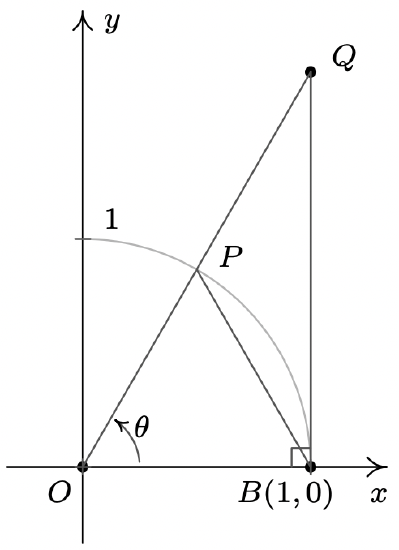
- Show that triangle \(OPB\) has area \(\dfrac{1}{2} \sin(\theta)\).
- Show that the circular sector \(OPB\) with central angle \(\theta\) has area \(\dfrac{1}{2} \theta\).
- Show that triangle \(OQB\) has area \(\dfrac{1}{2} \tan(\theta)\).
- Comparing areas, show that \(\sin(\theta) < \theta < \tan(\theta)\) for \(0 < \theta < \dfrac{\pi}{2}.\)
- Use the inequality \(\sin(\theta) < \theta\) to show that \(\dfrac{\sin(\theta)}{\theta} < 1\) for \(0 < \theta < \dfrac{\pi}{2}.\)
- Use the inequality \(\theta < \tan(\theta)\) to show that \(\cos(\theta) < \dfrac{\sin(\theta)}{\theta}\) for \(0 < \theta < \dfrac{\pi}{2}.\) Combine this with the previous part to complete the proof.
- Show that \(\cos(\theta) < \dfrac{\sin(\theta)}{\theta} < 1\) also holds for \(-\dfrac{\pi}{2}< \theta < 0\).
- Explain why the fact that \(\tan(\theta) = 3 = \frac{3}{1}\) does not mean \(\sin(\theta) = 3\) and \(\cos(\theta) = 1\)?
Answers
- \(\tan \left( \dfrac{\pi}{4} \right) = 1\)
- \(\sec \left( \dfrac{\pi}{6} \right) = \dfrac{2\sqrt{3}}{3}\)
- \(\csc \left( \dfrac{5\pi}{6} \right) = 2\)
- \(\cot \left( \dfrac{4\pi}{3} \right) = \dfrac{\sqrt{3}}{3}\)
- \(\tan \left( -\dfrac{11\pi}{6} \right) = \dfrac{\sqrt{3}}{3}\)
- \(\sec \left( -\dfrac{3\pi}{2} \right)\) is undefined
- \(\csc \left( -\dfrac{\pi}{3} \right) = -\dfrac{2\sqrt{3}}{3}\)
- \(\cot \left( \dfrac{13\pi}{2} \right) = 0\)
- \(\tan \left( 117\pi \right) = 0\)
- \(\sec \left( -\dfrac{5\pi}{3} \right) = 2\)
- \(\csc \left( 3\pi \right)\) is undefined
- \(\cot \left( -5\pi \right)\) is undefined
- \(\tan \left( \dfrac{31\pi}{2} \right)\) is undefined
- \(\sec \left( \dfrac{\pi}{4} \right) = \sqrt{2}\)
- \(\csc \left( -\dfrac{7\pi}{4} \right) = \sqrt{2}\)
- \(\cot \left( \dfrac{7\pi}{6} \right) = \sqrt{3}\)
- \(\tan \left( \dfrac{2\pi}{3} \right) = -\sqrt{3}\)
- \(\sec \left( -7\pi \right) = -1\)
- \(\csc \left( \dfrac{\pi}{2} \right) = 1\)
- \(\cot \left( \dfrac{3\pi}{4} \right) = -1\)
- \(\sin(\theta) = \frac{3}{5}, \cos(\theta) = -\frac{4}{5}, \tan(\theta) = -\frac{3}{4}, \csc(\theta) = \frac{5}{3}, \sec(\theta) = -\frac{5}{4}, \cot(\theta) = -\frac{4}{3}\)
- \(\sin(\theta) = -\frac{12}{13}, \cos(\theta) = -\frac{5}{13}, \tan(\theta) = \frac{12}{5}, \csc(\theta) = -\frac{13}{12}, \sec(\theta) = -\frac{13}{5}, \cot(\theta) = \frac{5}{12}\)
- \(\sin(\theta) = \frac{24}{25}, \cos(\theta) = \frac{7}{25}, \tan(\theta) = \frac{24}{7}, \csc(\theta) = \frac{25}{24}, \sec(\theta) = \frac{25}{7}, \cot(\theta) = \frac{7}{24}\)
- \(\sin(\theta) = \frac{-4\sqrt{3}}{7}, \cos(\theta) = \frac{1}{7}, \tan(\theta) = -4\sqrt{3}, \csc(\theta) = -\frac{7\sqrt{3}}{12}, \sec(\theta) = 7, \cot(\theta) = -\frac{\sqrt{3}}{12}\)
- \(\sin(\theta) = -\frac{\sqrt{91}}{10}, \cos(\theta) = -\frac{3}{10}, \tan(\theta) = \frac{\sqrt{91}}{3}, \csc(\theta) = -\frac{10\sqrt{91}}{91}, \sec(\theta) = -\frac{10}{3}, \cot(\theta) = \frac{3\sqrt{91}}{91}\)
- \(\sin(\theta) = \frac{\sqrt{530}}{530}, \cos(\theta) = -\frac{23\sqrt{530}}{530}, \tan(\theta) = -\frac{1}{23}, \csc(\theta) = \sqrt{530}, \sec(\theta) = -\frac{\sqrt{530}}{23}, \cot(\theta) = -23\)
- \(\sin(\theta) = -\frac{2\sqrt{5}}{5}, \cos(\theta) = \frac{\sqrt{5}}{5}, \tan(\theta) = -2, \csc(\theta) = -\frac{\sqrt{5}}{2}, \sec(\theta) = \sqrt{5}, \cot(\theta) = -\frac{1}{2}\)
- \(\sin(\theta) = \frac{\sqrt{15}}{4}, \cos(\theta) = -\frac{1}{4}, \tan(\theta) = -\sqrt{15}, \csc(\theta) = \frac{4\sqrt{15}}{15}, \sec(\theta) = -4, \cot(\theta) = -\frac{\sqrt{15}}{15}\)
- \(\sin(\theta) = -\frac{\sqrt{6}}{6}, \cos(\theta) = -\frac{\sqrt{30}}{6}, \tan(\theta) = \frac{\sqrt{5}}{5}, \csc(\theta) = -\sqrt{6}, \sec(\theta) = -\frac{\sqrt{30}}{5}, \cot(\theta) = \sqrt{5}\)
- \(\sin(\theta) = \frac{2\sqrt{2}}{3}, \cos(\theta) = \frac{1}{3}, \tan(\theta) = 2\sqrt{2}, \csc(\theta) = \frac{3\sqrt{2}}{4}, \sec(\theta) = 3, \cot(\theta) = \frac{\sqrt{2}}{4}\)
- \(\sin(\theta) = \frac{\sqrt{5}}{5}, \cos(\theta) = \frac{2\sqrt{5}}{5}, \tan(\theta) = \frac{1}{2}, \csc(\theta) = \sqrt{5}, \sec(\theta) = \frac{\sqrt{5}}{2}, \cot(\theta) = 2\)
- \(\sin(\theta) = \frac{1}{5}, \cos(\theta) = -\frac{2\sqrt{6}}{5}, \tan(\theta) = -\frac{\sqrt{6}}{12}, \csc(\theta) = 5, \sec(\theta) = -\frac{5\sqrt{6}}{12}, \cot(\theta) = -2\sqrt{6}\)
- \(\sin(\theta) = -\frac{\sqrt{110}}{11}, \cos(\theta) = -\frac{\sqrt{11}}{11}, \tan(\theta) = \sqrt{10}, \csc(\theta) = -\frac{\sqrt{110}}{10}, \sec(\theta) = -\sqrt{11}, \cot(\theta) = \frac{\sqrt{10}}{10}\)
- \(\sin(\theta) = -\frac{\sqrt{95}}{10}, \cos(\theta) = \frac{\sqrt{5}}{10}, \tan(\theta) = -\sqrt{19}, \csc(\theta) = -\frac{2\sqrt{95}}{19}, \sec(\theta) = 2\sqrt{5}, \cot(\theta) = -\frac{\sqrt{19}}{19}\)
- \(\csc(78.95^{\circ}) \approx 1.019\)
- \(\tan(-2.01) \approx 2.129\)
- \(\cot(392.994) \approx 3.292\)
- \(\sec(207^{\circ}) \approx -1.122\)
- \(\csc(5.902) \approx -2.688\)
- \(\tan(39.672^{\circ}) \approx 0.829\)
- \(\cot(3^{\circ}) \approx 19.081\)
- \(\sec(0.45) \approx 1.111\)
- \(\tan(\theta) = \sqrt{3}\) when \(\theta = \dfrac{\pi}{3} + \pi k\) for any integer \(k\)
- \(\sec(\theta) = 2\) when \(\theta = \dfrac{\pi}{3} + 2\pi k\) or \(\theta = \dfrac{5\pi}{3} + 2\pi k\) for any integer \(k\)
- \(\csc(\theta) = -1\) when \(\theta = \dfrac{3\pi}{2} + 2\pi k\) for any integer \(k\).
- \(\cot(\theta) = \dfrac{\sqrt{3}}{3}\) when \(\theta = \dfrac{\pi}{3} + \pi k\) for any integer \(k\)
- \(\tan(\theta) = 0\) when \(\theta = \pi k\) for any integer \(k\)
- \(\sec(\theta) = 1\) when \(\theta = 2\pi k\) for any integer \(k\)
- \(\csc(\theta) = 2\) when \(\theta = \dfrac{\pi}{6} + 2\pi k\) or \(\theta = \dfrac{5\pi}{6} + 2\pi k\) for any integer \(k\).
- \(\cot(\theta) = 0\) when \(\theta = \dfrac{\pi}{2} + \pi k\) for any integer \(k\)
- \(\tan(\theta) = -1\) when \(\theta = \dfrac{3\pi}{4} + \pi k\) for any integer \(k\)
- \(\sec(\theta) = 0\) never happens
- \(\csc(\theta) = -\dfrac{1}{2}\) never happens
- \(\sec(\theta) = -1\) when \(\theta = \pi + 2\pi k = (2k+1)\pi\) for any integer \(k\)
- \(\tan(\theta) = -\sqrt{3}\) when \(\theta = \dfrac{2\pi}{3} + \pi k\) for any integer \(k\)
- \(\csc(\theta) = -2\) when \(\theta = \dfrac{7\pi}{6} + 2\pi k\) or \(\theta = \dfrac{11\pi}{6} + 2\pi k\) for any integer \(k\)
- \(\cot(\theta) = -1\) when \(\theta = \dfrac{3\pi}{4} + \pi k\) for any integer \(k\)
- \(\cot(t) = 1\) when \(t = \dfrac{\pi}{4} + \pi k\) for any integer \(k\)
- \(\tan(t) = \dfrac{\sqrt{3}}{3}\) when \(t = \dfrac{\pi}{6} + \pi k\) for any integer \(k\)
- \(\sec(t) = -\dfrac{2\sqrt{3}}{3}\) when \(t = \dfrac{5\pi}{6} + 2\pi k\) or \(t = \dfrac{7\pi}{6} + 2\pi k\) for any integer \(k\)
- \(\csc(t) = 0\) never happens
- \(\cot(t) = -\sqrt{3}\) when \(t = \dfrac{5\pi}{6} + \pi k\) for any integer \(k\)
- \(\tan(t) = -\dfrac{\sqrt{3}}{3}\) when \(t = \dfrac{5\pi}{6} + \pi k\) for any integer \(k\)
- \(\sec(t) = \dfrac{2\sqrt{3}}{3}\) when \(t = \dfrac{\pi}{6} + 2\pi k\) or \(t = \dfrac{11\pi}{6} + 2\pi k\) for any integer \(k\)
- \(\csc(t) = \dfrac{2\sqrt{3}}{3}\) when \(t = \dfrac{\pi}{3} + 2\pi k\) or \(t = \dfrac{2\pi}{3} + 2\pi k\) for any integer \(k\)
- \(\theta = 30^{\circ}\), \(a = 3\sqrt{3}\), \(c = \sqrt{108} = 6\sqrt{3}\)
- \(\alpha = 56^{\circ}\), \(b = 12 \tan(34^{\circ}) = 8.094\), \(c = 12\sec(34^{\circ}) = \dfrac{12}{\cos(34^{\circ})} \approx 14.475\)
- \(\theta = 43^{\circ}\), \(a = 6\cot(47^{\circ}) = \dfrac{6}{\tan(47^{\circ})} \approx 5.595\), \(c = 6\csc(47^{\circ}) = \dfrac{6}{\sin(47^{\circ})} \approx 8.204\)
- \(\beta = 40^{\circ}\), \(b = 2.5 \tan(50^{\circ}) \approx 2.979\), \(c = 2.5\sec(50^{\circ}) = \dfrac{2.5}{\cos(50^{\circ})} \approx 3.889\)
- The side adjacent to \(\theta\) has length \(4\sqrt{3} \approx 6.928\)
- The side opposite \(\theta\) has length \(10 \sin(15^{\circ}) \approx 2.588\)
- The side opposite \(\theta\) is \(2\tan(87^{\circ}) \approx 38.162\)
- The hypoteneuse has length \(14 \csc(38.2^{\circ}) = \dfrac{14}{\sin(38.2^{\circ})} \approx 22.639\)
- The side adjacent to \(\theta\) has length \(3.98 \cos(2.05^{\circ}) \approx 3.977\)
- The side opposite \(\theta\) has length \(31\tan(42^{\circ}) \approx 27.912\)
- The tree is about 47 feet tall.
- The lights are about 75 feet apart.
-
- The fire is about 4581 feet from the base of the tower.
- The Sasquatch ran \(200\cot(6^{\circ}) - 200\cot(6.5^{\circ}) \approx 147\) feet in those 10 seconds. This translates to \(\approx 10\) miles per hour. At the scene of the second sighting, the Sasquatch was \(\approx 1755\) feet from the tower, which means, if it keeps up this pace, it will reach the tower in about \(2\) minutes.
- The tree is about 41 feet tall.
- The boat has traveled about 244 feet.
- The tower is about 682 feet tall. The guy wire hits the ground about 731 feet away from the base of the tower.

